1. Excler JL, Saville M, Berkley S, Kim JH. Vaccine development for emerging infectious diseases. Nat Med. 2021; 27(4):591–600. PMID:
33846611.
2. Torequl Islam M, Nasiruddin M, Khan IN, Mishra SK, Kudrat-E-Zahan M, Alam Riaz T, et al. A perspective on emerging therapeutic interventions for COVID-19. Front Public Health. 2020; 8:281. PMID:
32733837.
5. Wantha O, Mahakkanukrauh A, Tuydaung K, Donsrichan W, Yingyaun K, Kaewmeun S, et al. Attitudes and factors affecting decision-making regarding COVID-19 vaccination among autoimmune rheumatic disease patients. Int J Rheum Dis. 2023; 26(4):751–758. PMID:
36872073.
6. Troiano G, Nardi A. Vaccine hesitancy in the era of COVID-19. Public Health. 2021; 194:245–251. PMID:
33965796.
7. Tsai R, Hervey J, Hoffman K, Wood J, Johnson J, Deighton D, et al. COVID-19 vaccine hesitancy and acceptance among individuals with cancer, autoimmune diseases, or other serious comorbid conditions: cross-sectional, internet-based survey. JMIR Public Health Surveill. 2022; 8(1):e29872. PMID:
34709184.
8. Doornekamp L, van Leeuwen L, van Gorp E, Voeten H, Goeijenbier M. Determinants of vaccination uptake in risk populations: a comprehensive literature review. Vaccines (Basel). 2020; 8(3):480. PMID:
32867126.
9. Boekel L, Kummer LY, van Dam KP, Hooijberg F, van Kempen Z, Vogelzang EH, et al. Adverse events after first COVID-19 vaccination in patients with autoimmune diseases. Lancet Rheumatol. 2021; 3(8):e542–e545. PMID:
34179831.
10. Sen P, Ravichandran N, Nune A, Lilleker JB, Agarwal V, Kardes S, et al. COVID-19 vaccination-related adverse events among autoimmune disease patients: results from the COVAD study. Rheumatology (Oxford). 2022; 62(1):65–76. PMID:
35713499.
11. Kato Y, Morita T, Kumanogoh A. Efficacy and risk of mRNA vaccination in patients with autoimmune inflammatory rheumatic diseases. Inflamm Regen. 2023; 43(1):1. PMID:
36609472.
12. Naveen R, Nikiphorou E, Joshi M, Sen P, Lindblom J, Agarwal V, et al. Safety and tolerance of vaccines against SARS-CoV-2 infection in systemic lupus erythematosus: results from the COVAD study. Rheumatology (Oxford). 2023; 62(7):2453–2463. PMID:
36413073.
13. Chen Y, Xu Z, Wang P, Li XM, Shuai ZW, Ye DQ, et al. New-onset autoimmune phenomena post-COVID-19 vaccination. Immunology. 2022; 165(4):386–401. PMID:
34957554.
14. Wraith DC, Goldman M, Lambert PH. Vaccination and autoimmune disease: what is the evidence? Lancet. 2003; 362(9396):1659–1666. PMID:
14630450.
15. Olivieri B, Betterle C, Zanoni G. Vaccinations and autoimmune diseases. Vaccines (Basel). 2021; 9(8):815. PMID:
34451940.
16. Pellegrino P, Carnovale C, Pozzi M, Antoniazzi S, Perrone V, Salvati D, et al. On the relationship between human papilloma virus vaccine and autoimmune diseases. Autoimmun Rev. 2014; 13(7):736–741. PMID:
24468416.
17. Gaur PS, Zimba O, Agarwal V, Gupta L. Reporting survey based studies – a primer for authors. J Korean Med Sci. 2020; 35(45):e398. PMID:
33230988.
18. Li X, Yang X, Ning Z. Efficacy and safety of COVID-19 inactivated vaccine: a meta-analysis. Front Med (Lausanne). 2022; 9:1015184. PMID:
36419789.
19. Kaur RJ, Dutta S, Bhardwaj P, Charan J, Dhingra S, Mitra P, et al. Adverse events reported from COVID-19 vaccine trials: a systematic review. Indian J Clin Biochem. 2021; 36(4):427–439. PMID:
33814753.
20. Kim MS, Jung SY, Ahn JG, Park SJ, Shoenfeld Y, Kronbichler A, et al. Comparative safety of mRNA COVID-19 vaccines to influenza vaccines: a pharmacovigilance analysis using WHO international database. J Med Virol. 2022; 94(3):1085–1095. PMID:
34709664.
21. Machado PM, Lawson-Tovey S, Strangfeld A, Mateus EF, Hyrich KL, Gossec L, et al. Safety of vaccination against SARS-CoV-2 in people with rheumatic and musculoskeletal diseases: results from the EULAR Coronavirus Vaccine (COVAX) physician-reported registry. Ann Rheum Dis. 2022; 81(5):695–709. PMID:
34972811.
22. Cross JW, Joy M, McGee C, Akinyemi O, Gatenby P, de Lusignan S. Adverse events of interest vary by influenza vaccine type and brand: sentinel network study of eight seasons (2010-2018). Vaccine. 2020; 38(22):3869–3880. PMID:
32299719.
23. Abukhalil AD, Shatat SS, Abushehadeh RR, Al-Shami N, Naseef HA, Rabba A. Side effects of Pfizer/BioNTech (BNT162b2) COVID-19 vaccine reported by the Birzeit University community. BMC Infect Dis. 2023; 23(1):5. PMID:
36604613.
24. Inanc N, Kostov B, Priori R, Flores-Chavez A, Carubbi F, Szántó A, et al. Safety and efficacy of SARS-CoV-2 vaccination in 1237 patients with primary Sjögren syndrome. Clin Exp Rheumatol. 2022; 40(12):2290–2297. PMID:
36441656.
25. Naveen R, Parodis I, Joshi M, Sen P, Lindblom J, Agarwal V, et al. COVID-19 vaccination in autoimmune diseases (COVAD) Study: vaccine safety and tolerance in rheumatoid arthritis. Rheumatology (Oxford). 2023; 62(7):2366–2376. PMID:
36315075.
26. Gil-Vila A, Ravichandran N, Selva-O’Callaghan A, Sen P, Nune A, Gaur PS, et al. COVID-19 Vaccination in Autoimmune Diseases (COVAD) study: vaccine safety in idiopathic inflammatory myopathies. Muscle Nerve. 2022; 66(4):426–437. PMID:
35869701.
27. Yi Z, Yao Z, Xu D, Xu C, Fang W, Guo Z, et al. Attitudes toward COVID-19 vaccination: a survey of Chinese patients with rheumatic diseases. Vaccines (Basel). 2022; 10(10):1604. PMID:
36298469.
28. Li YK, Lui MP, Yam LL, Cheng CS, Tsang TH, Kwok WS, et al. COVID-19 vaccination in patients with rheumatic diseases: Vaccination rates, patient perspectives, and side effects. Immun Inflamm Dis. 2022; 10(3):e589. PMID:
35099852.
29. Esquivel-Valerio JA, Skinner-Taylor CM, Moreno-Arquieta IA, Cardenas-de la Garza JA, Garcia-Arellano G, Gonzalez-Garcia PL, et al. Adverse events of six COVID-19 vaccines in patients with autoimmune rheumatic diseases: a cross-sectional study. Rheumatol Int. 2021; 41(12):2105–2108. PMID:
34622311.
30. Gallo AT, Scanlon L, Clifford J, Patten-Williams L, Tweedie L, Li D, et al. Immediate adverse events following COVID-19 vaccination in Australian pharmacies: a retrospective review. Vaccines (Basel). 2022; 10(12):2041. PMID:
36560451.
31. Guo W, Deguise J, Tian Y, Huang PC, Goru R, Yang Q, et al. Profiling COVID-19 vaccine adverse events by statistical and ontological analysis of VAERS case reports. Front Pharmacol. 2022; 13:870599. PMID:
35814246.
32. Kouhpayeh H, Ansari H. Adverse events following COVID-19 vaccination: a systematic review and meta-analysis. Int Immunopharmacol. 2022; 109:108906. PMID:
35671640.
33. Krasselt M. To vaccinate or not to vaccinate: on vaccine hesitancy decreases in rheumatic diseases. Rheumatology (Oxford). 2023; kead126. PMID:
36929927.
34. Connolly CM, Ruddy JA, Boyarsky BJ, Barbur I, Werbel WA, Geetha D, et al. Disease flare and reactogenicity in patients with rheumatic and musculoskeletal diseases following two-dose SARS-CoV-2 messenger RNA vaccination. Arthritis Rheumatol. 2022; 74(1):28–32. PMID:
34346185.
35. Hazlewood GS, Colmegna I, Hitchon C, Fortin PR, Bernatsky S, Clarke AE, et al. Preferences for COVID-19 vaccination in people with chronic immune-mediated inflammatory diseases. J Rheumatol. 2023; 50(7):949–957. PMID:
36642432.
36. Ma M, Santosa A, Fong W, Chew LC, Low AH, Law A, et al. Post-mRNA vaccine flares in autoimmune inflammatory rheumatic diseases: results from the COronavirus National Vaccine registry for ImmuNe diseases SINGapore (CONVIN-SING). J Autoimmun. 2023; 134:102959. PMID:
36473406.
37. Izmirly PM, Kim MY, Samanovic M, Fernandez-Ruiz R, Ohana S, Deonaraine KK, et al. Evaluation of immune response and disease status in SLE patients following SARS-CoV-2 vaccination. Arthritis Rheumatol. 2021; 74(2):284–294. PMID:
34347939.
38. Furer V, Eviatar T, Zisman D, Peleg H, Paran D, Levartovsky D, et al. Immunogenicity and safety of the BNT162b2 mRNA COVID-19 vaccine in adult patients with autoimmune inflammatory rheumatic diseases and in the general population: a multicentre study. Ann Rheum Dis. 2021; 80(10):1330–1338. PMID:
34127481.
39. Nakafero G, Grainge MJ, Myles PR, Mallen CD, Zhang W, Doherty M, et al. Association between inactivated influenza vaccine and primary care consultations for autoimmune rheumatic disease flares: a self-controlled case series study using data from the Clinical Practice Research Datalink. Ann Rheum Dis. 2019; 78(8):1122–1126. PMID:
31036623.
40. Trougakos IP, Terpos E, Alexopoulos H, Politou M, Paraskevis D, Scorilas A, et al. Adverse effects of COVID-19 mRNA vaccines: the spike hypothesis. Trends Mol Med. 2022; 28(7):542–554. PMID:
35537987.
41. Alshahrani MM, Alqahtani A. Side effects of mixing vaccines against COVID-19 infection among Saudi population. Vaccines (Basel). 2022; 10(4):519. PMID:
35455268.
42. Jara A, Undurraga EA, Zubizarreta JR, González C, Pizarro A, Acevedo J, et al. Effectiveness of homologous and heterologous booster doses for an inactivated SARS-CoV-2 vaccine: a large-scale prospective cohort study. Lancet Glob Health. 2022; 10(6):e798–e806. PMID:
35472300.
43. Li L, Robinson LB, Patel R, Landman AB, Fu X, Shenoy ES, et al. Association of self-reported high-risk allergy history with allergy symptoms after COVID-19 vaccination. JAMA Netw Open. 2021; 4(10):e2131034. PMID:
34698847.
44. Wieske L, Kummer LY, van Dam KP, Stalman EW, van der Kooi AJ, Raaphorst J, et al. Risk factors associated with short-term adverse events after SARS-CoV-2 vaccination in patients with immune-mediated inflammatory diseases. BMC Med. 2022; 20(1):100. PMID:
35236350.
45. Álvaro-Gracia JM, Sanchez-Piedra C, Culqui D, Rosello R, Garcia-Dorta A, Campos C, et al. Effects of COVID-19 vaccination on disease activity in patients with rheumatoid arthritis and psoriatic arthritis on targeted therapy in the COVIDSER study. RMD Open. 2023; 9(1):e002936. PMID:
36927849.
46. Rider LG, Parks CG, Wilkerson J, Schiffenbauer AI, Kwok RK, Noroozi Farhadi P, et al. Baseline factors associated with self-reported disease flares following COVID-19 vaccination among adults with systemic rheumatic disease: results from the COVID-19 global rheumatology alliance vaccine survey. Rheumatology (Oxford). 2022; 61(SI2):SI143–SI150. PMID:
35460240.
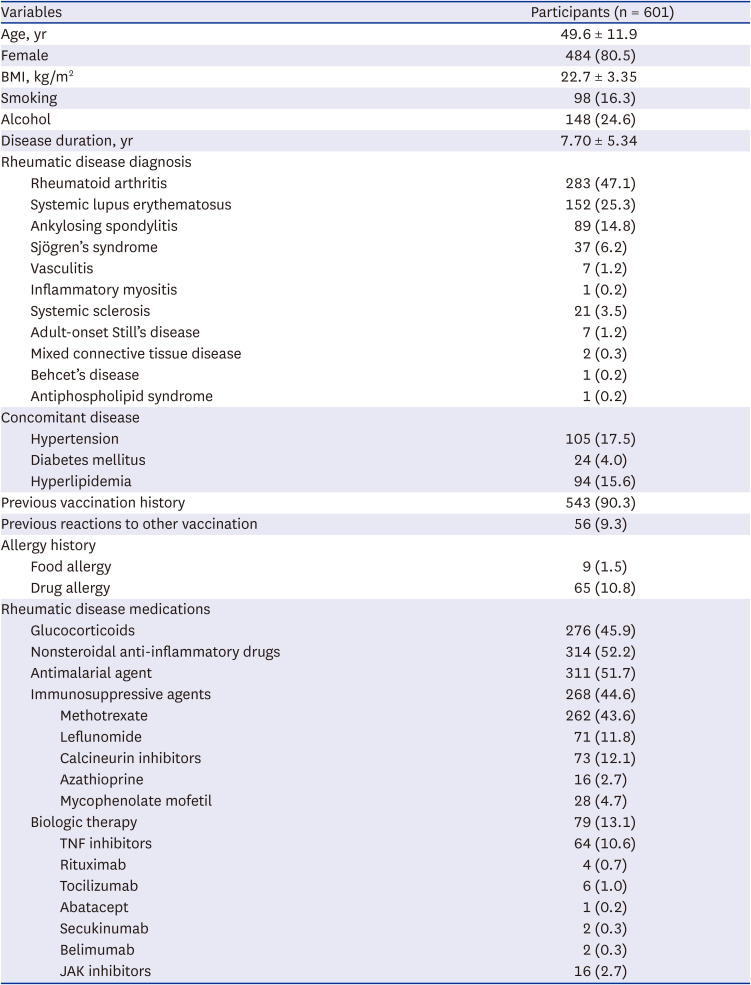
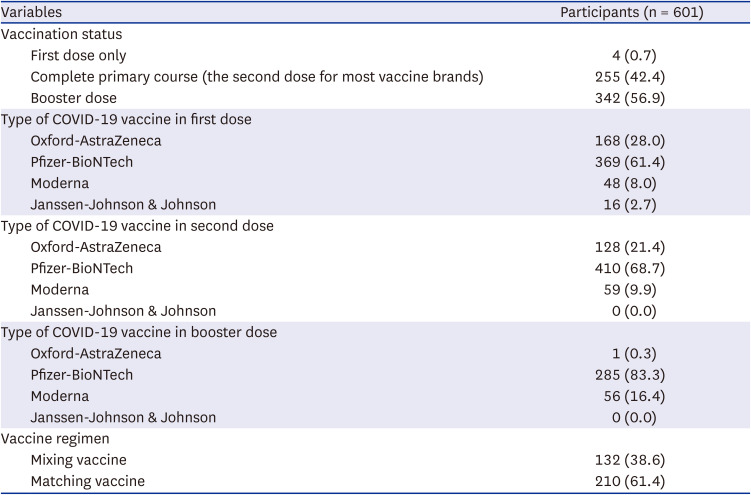
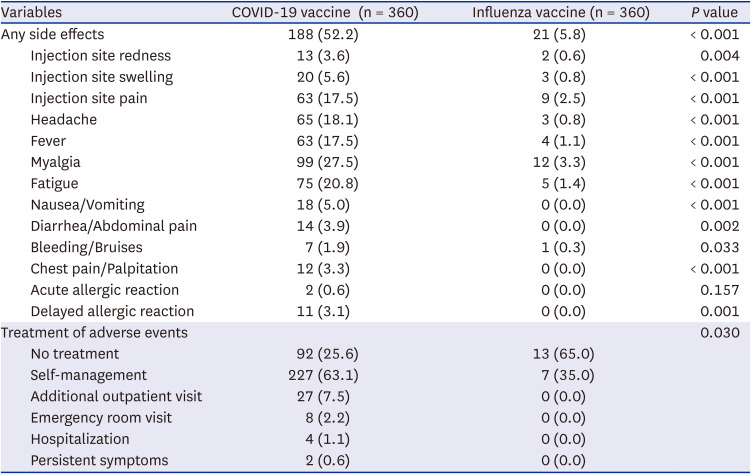
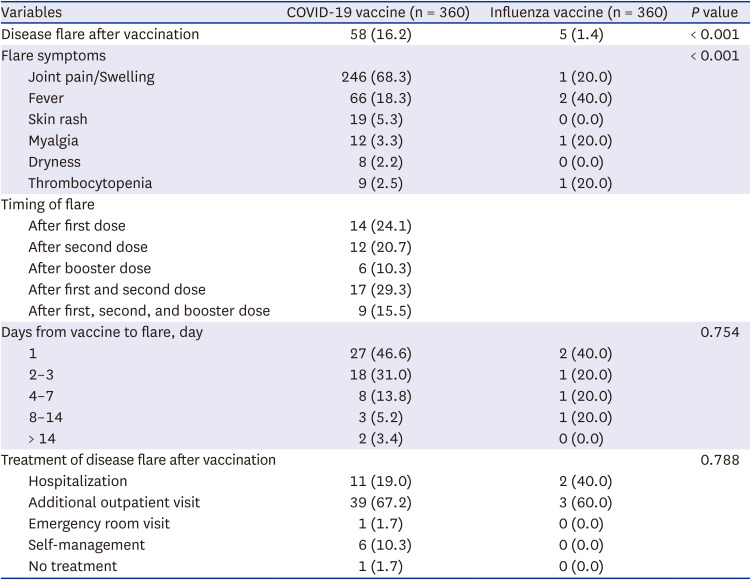
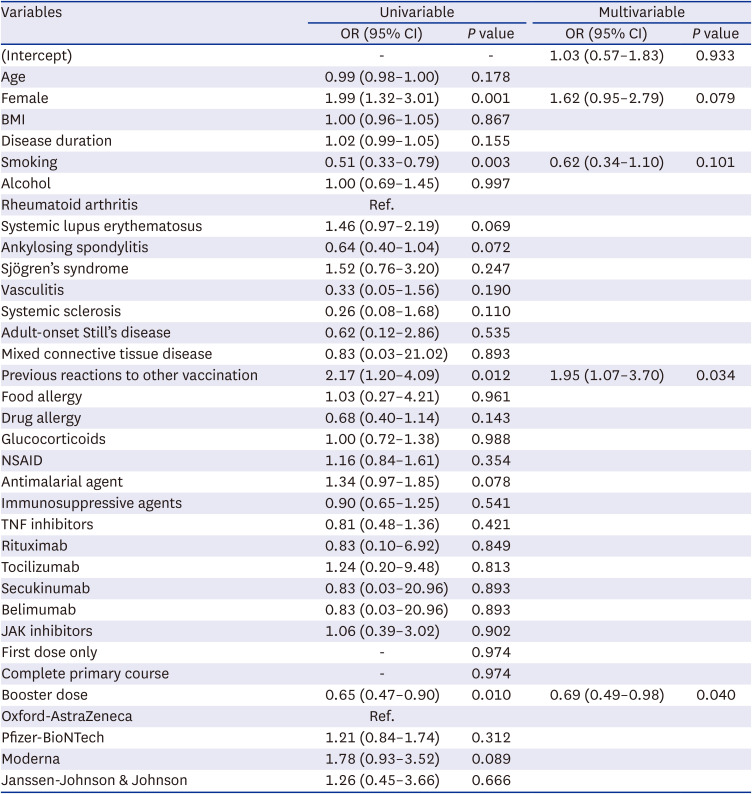
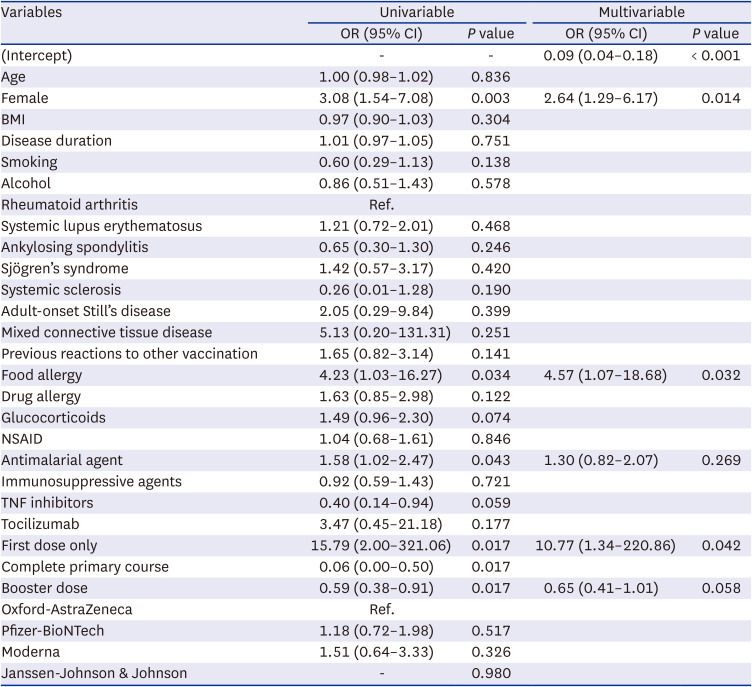




 PDF
PDF Citation
Citation Print
Print



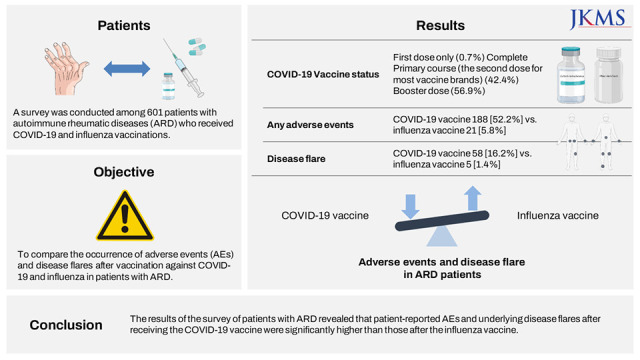
 XML Download
XML Download